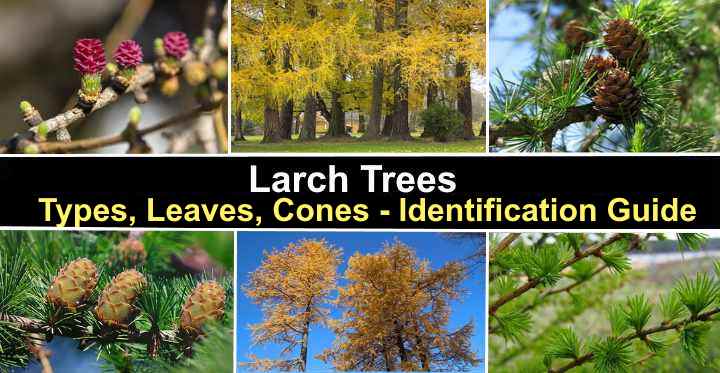Larch trees (botanical name Larix) are large deciduous conifers with needle-like foliage that grow in tiny clusters on branches. The pyramidal growth of larch trees, which is common to most conifer species, is used to identify them. Larch trees, on the other hand, lose their leaves in the autumn and become golden yellow. In the spring, larches are usually the first deciduous trees to produce leaves.
The native habitat of larch trees is in the Northern Hemisphere’s cool, temperate zones. Washington, Oregon, Montana, Minnesota, and West Virginia are among the states where larch trees may be found. In Canada and Alaska’s subalpine forests, North American larch trees also grow. American Larch (Larix laricina) and Western Larch (Larix occidentalis) are the two most commonly found larch species. These conical conifers may grow up to 70 feet (21 meters) tall.
This article covers everything you need to know about the most common types of larch trees found in North American, European, and Asian temperate and subarctic woods. Larix species may be identified by descriptions of deciduous conifers and images of larch tree bark, leaves, cones, and flowers.
Larch Tree Facts

The genus Larix and the pine family Pinaceae include tall deciduous conifers called larch trees. Larch trees come in a variety of species, ranging from ten to twelve. The huge trees, like most conifers, have a conical, pyramidal growth. Larches grow in zones 2 through 5 and are also cold-tolerant.
Larch trees are deciduous trees that lose their needle leaves in the autumn, which distinguishes them from other coniferous trees. Larch trees’ greenish-yellow to golden yellow hues contrast with evergreen fir trees, hemlocks, cedars, and junipers when their leaves turn color in the autumn.
During the autumn, hikers flock to states where larches may be found, such as Washington. In the fall, the yellow larches and evergreen conifers combine to create a stunning mountainous landscape. Larches have needle leaves and seed-bearing cones, much like pine trees.
Larch trees have a naked appearance in the winter, unlike pines. The larch appears to be in bloom thanks to its little colorful larch cones. Larch trees, which can live for hundreds of years, are typically fast-growing deciduous conifers.
Larch Tree vs. Tamarack
The tamarack is the most widely planted larch tree in North America. The eastern or American larch (Larix laricina) is also known as Tamarack. Hackmatack, black larch, and red larch are some of the other names for this common larch tree. In the United States’ northern states, tamaracks are abundant.
Tamarack trees grow up to 60 feet (18 meters) tall and are small to medium in size. Newfoundland, Minnesota, West Virginia, Montana, and Wisconsin have high concentrations of tamaracks. Tamarack trees have the smallest flower-like cones of any larch species. The redness of the cones changes to brown as they mature.
Larch Tree Leaves

In the fall, before they shed their leaves, larch tree leaves become needle-shaped and yellow. Green larch leaves, up to 2″ (5 cm) long, grow in clusters on woody pegs. Each peg has between 15 and 30 needle-like leaves. Up to 40 needles per woody peg exist on some larch species, such as the subalpine larch.
The exquisite yellow color of the needle leaves in the fall is a distinguishing characteristic of larch trees. The few conifers that lose their leaves in the autumn are larches. When the larches turn their fall color in the autumn, coniferous and deciduous woods become patches of warm bronze-yellow hues.
Larch Flowers

Female flowers are on the left in the image, while male flowers are on the right in the image. A close-up picture of larch strobili (larch seed cones): female strobili on the left, while male strobili on the right. Before they turn brown cones, the colorful female larch flowers (or cones) may be orangey-yellow, purple, brilliant red, or green.
Larch “flowers” may range in length from 1 to 9 cm (0.5 to 3.5″). Nevertheless, the larch species determines the size and color of the flower. Male larch flowers (also known as little seed cones) are globular or oblong and have a creamy white color. Oblong female strobili grow upright on branches and stand erect.
Larch Tree Cones
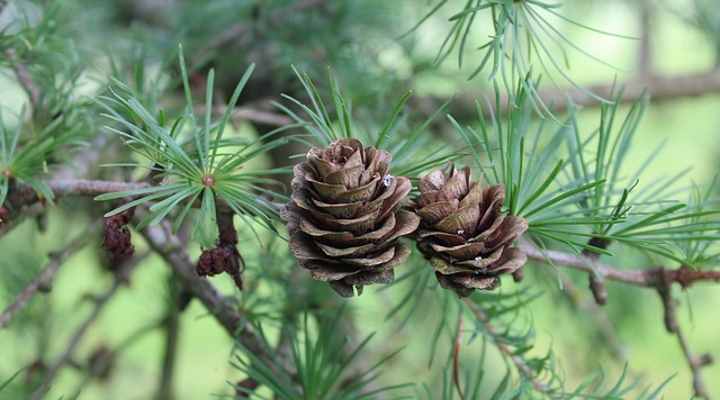
Larch is a cone-producing tree, with two female cones in the center and little male cones on the left. The oval to egg-shaped cylindrical larch seed cones range in length from 0.5 inch to 3.5 inch (1 – 9 cm). The cones of northern larch trees are the tiniest, while those of southern larches are the longest. Green whisker-like leaves that grow between the cone’s reddish-brown scales distinguish certain larch species.
Larch Tree Identification
When the typical flat, pine-like needles turn yellow before falling to the ground, it’s simple to recognize larch trees in the fall by their warm yellow hues. The pinkish or reddish-brown bark of larches is also distinguished by shallow fissures. Larches with oval cones and a pyramidal growth habit may be seen in woodlands.
Larch Trees in Winter

In the winter, larches lose their leaves, making them one of the few conifer species without any foliage. In winter, the easiest way to identify the species is by noting the absence of pine needles on larch trees. On the coniferous woodland floor, the fallen needle leaves leave a delightful mulch.
Larches are one of the few conifer trees to have winter or spring flowers growing around the root base, thanks to the greater amount of light that reaches the ground due to their lack of foliage. In winter, a layer of bluebells or other early spring blossoms may be seen covering the ground beneath larch trees.
Types of Larch Trees (With Pictures)
Now, let’s take a closer look at different larch species. You may learn about the traits of each tree by reading descriptions of each larch variety.
American Larch (Larix laricina)

The American larch (Larix laricina) is a medium-sized deciduous conifer with a conical shape, flaky reddish-brown bark, soft feathery needle foliage, and tiny cylindrical cones. It’s also known as tamarack. American larch trees, also known as tamarack, grow to be about 30–60 feet (10–20 meters) tall. Tamaracks’ vivid yellow color makes them easy to spot in the fall.
Canada and the northeastern United States are home to American larches. USDA zones 2 to 5 are ideal for American larch trees. Deciduous conifers flourish best in bogs and woodlands with poor drainage. The fast-growing larch is a great specimen tree in a big landscape.
Because of their color, mature American larches are known as the red larch. They have reddish-brown scaly bark. In contrast, immature American larch is smooth and gray. The bark appears to be flaky and thin when mature. American larch trees with a slender, pyramidal growth habit are known as tall, skinny trees. The branchless trunk and crown, which starts to expand halfway up the tree, distinguish the slender larch in coniferous woodlands.

American larch leaves (needles) In the spring and summer, it takes on a light blue-green hue. Each needle-like leaf is approximately 1 inch (2.5 cm) long. Tamarack leaves, like other larches, develop in dense clusters of up to 30 needles on long woody branches. On the branches, the larch leaves are spirally arranged.
American larch cones The Larix genus includes some of the tiniest conifers. Between 0.4″ and 0.8″ (1–2 cm) long, the conical cones are small. The larch cones are vivid red when they first emerge. As they age throughout the season, they gradually turn brown. After pollination, the mature larch seed cones produce seeds that ripens around six months.

American larch flowers The immature colorful cones are also known as “coral cones.” Since they appear like pinkish red clusters that stand tall on branches, the cones are called flowers. The “flowers” are delicate when they first emerge. However, as they age, they harden and turn brown.
Western Larch (Larix occidentalis)

The Western larch (Larix occidentalis) is a tall conifer with flaky brown bark and clusters of light green needle leaves growing from woody pegs. It is native to the Pacific Northwest and grows in dense forests. Between 100 and 200 feet (30 to 60 meters) tall, this enormous coniferous tree The small conical crown and brilliant yellow autumn color distinguish the Western larch.
USDA zones 4 and above are ideal for Western larch. It can be found in Washington, Oregon, and Montana, as well as Canadian woodlands, in its natural habitat. Western larch grows exclusively in well-draining soil, unlike Eastern larch. Temperatures as low as -58°F (-50°C) may be tolerated by the tree.
Western larches are unique conifers with distinctive growth characteristics. It has a long, thin body. Conelike cones with conspicuous whiskers protruding from the scales and flaky gray or brown bark, and its branches have clumps of needles like pine trees. One of Washington state’s two native larch species is the Western Larch. Alpine larch (Larix lyallii) is the other kind of tree.
Hackmatack or western tamarack are two names for western larches. Framing, construction, finishing labor, and firewood are all made out of it. Western larches are important trees in the paper pulp industry in many countries.

Western larch needle leaves develop in short clusters on branches and are delicate, long, slender needle leaves. The light green larch leaves turn golden yellow in the autumn, and during the winter, the leaves fall away, leaving naked orange-brown shoots.

Immature cones (left) and mature cones (right) of western larch Whiskery growths on the scaly bracts of the conical reddish cones. Six months after being pollinated, cones develop as reddish-purple larch flower-like strobili that turn brown and drop seeds.
European Larch (Larix decidua)
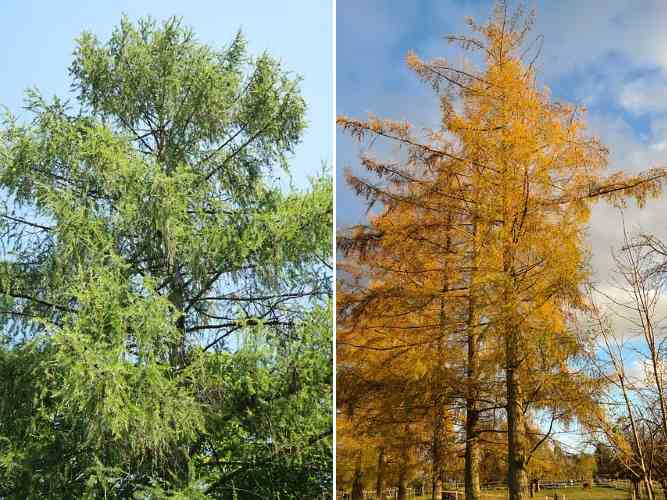
The deciduous conifer Larix decidua grows between 82 and 150 feet (25 and 45 meters) tall, and is found in Europe. The conical crown and pyramidal shape, red cones that turn green then brown, and light-green needle-like leaves distinguish the European larch from other species. European larches brighten an evergreen forested environment in the autumn, turning bright yellow.
The highland areas of central Europe are home to European larches. Hardy conifers, which can survive temperatures as low as -58°F (-50°С), thrive in USDA zones 2 through 9. The European larch should be planted in well-drained, full-sun soil for optimum growth.
You can find European larches in the Appalachian highlands as well as Michigan, Connecticut, Rhode Island, and New Hampshire. In comparison to tamaracks, European larches are better able to survive warmer temperatures. The decorative tree Europeans larch is also popular.

Male cones grow between 0.8″ and 1.5″ (2 – 4 cm) long on European larch leaves. The needle-shaped leaves of larch spread in tight bunches on the branches, looking like they are growing in clusters. Little pegs protrude from the green leaves. In the summer, they turn blue-green, and in the autumn, they change to golden yellow.

European larch cones emerge as reddish flower-like egg-shaped clusters (left) with fully developed cones (right). The bright bracts turn brown as the season progresses and drop seeds in the winter. Cones may grow alongside newly appearing, colored cones on the larch for up to ten years.
Weeping Larch (Larix decidua ‘Pendula’)

The weeping larch (Larix decidua “Pendula”) is a tiny, fast-growing decorative tree with pine-like needle leaves and narrowly ovate cones. It’s a young cone. The pendulous branches are densely covered in soft, tufty bright green needle leaves. The dwarf larch may reach a height of 12 feet (3.5 meters) and an width of 8 feet (2.4 meters). The irregular crown and branches that droop to the ground distinguish the weeping larch.
If you have a tiny or compact yard, weeping larch is an excellent dwarf tree to grow. The weeping larch branches are covered in thick feathery foliage throughout the spring and summer. As the soft needles fall to the ground in the autumn, the larch turns a magnificent golden yellow.
In full sun and well-drained soil, you may grow a weeping larch. USDA zones 2 through 7 are ideal for the larch cultivar. As a lawn tree, specimen tree, or growing in a big pot, this magnificent decorative tree with its elegant flowing branches is exquisite. The weeping Japanese larch (Larix kaempferi ‘Pendula’) is easily confused with this dwarf weeping conifer.
Japanese Larch (Larix kaempferi)

The Japanese larch (Larix kaempferi) is a robust conifer with blue-green clusters of needle leaves, tiny purple cones, and a conical form. It grows in Japan. The deciduous larch can reach heights of 65 to 103 feet (20 to 40 meters). As the tree develops, the larch is recognized by its spreading, irregular branches.

Little, upright conical flower-like strobili that emerge violet are the Japanese larch’s characteristic. Before becoming dark brown, the larch “flowers” develop into orange-brown cones. During the summer, the tree’s leaves are gray to green, while in the autumn, they turn golden yellow.
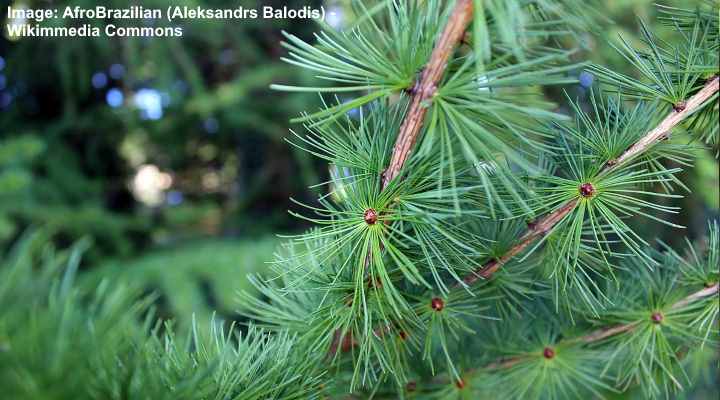
The Japanese larch is appropriate for big landscapes because of its huge size. When grown in well-drained soil, the tree thrives in USDA zones 4 through 7. The larch, on the other hand, thrives beside streams and ponds and is tolerant of wet conditions. Several larch cultivars exist to appeal to a variety of tastes. The Japanese larch bonsai is a miniature form of the tree.

Dwarf conifers, such as ‘Blue Dwarf’ and ‘Nana,’ are excellent for potted larch trees or growing in small gardens, growing from 3 to 4 feet (1.5 to 1.5 m) tall.
Weeping Japanese Larch (Larix kaempferi ‘Pendula’)

The weeping Japanese larch (Larix kaempferi ‘Pendula’) is a lovely cultivar with feathery, light green leaves that cascade down from weeping branches. Mounding shrub, arching small tree, or weeping conifer are all options for training the dwarf coniferous tree. Even in full sun, its trailing branches will create ground cover.
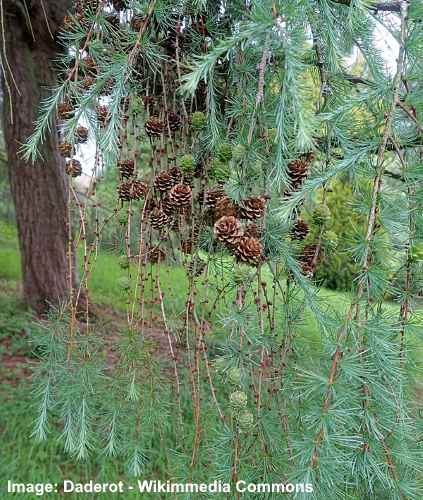
The weeping Japanese larch ‘Pendula’ thrives in USDA zones 4 to 7, featuring weeping Japanese larch leaves and cones. The fast-growing, little, hardy tree grows to be 15 to 30 feet (4 to 9 meters) tall and broad.
Siberian Larch (Larix sibirica)
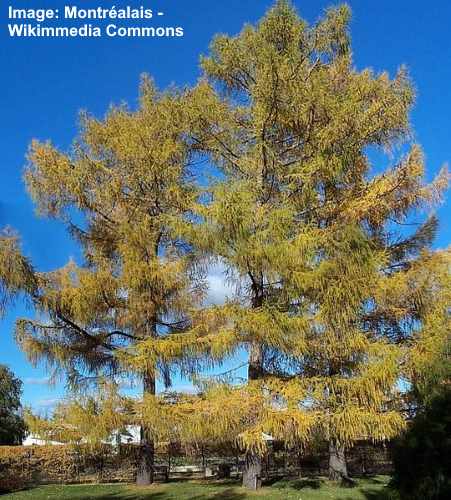
The Siberian larch (Larix sibirica) is a huge conifer that sheds its leaves in the autumn. The horizontal branching, conical crown, and pendulous side branches distinguish the stunning landscape tree. Larches in Siberia may grow to be 164 feet (50 meters) tall. USDA zones 2 to 8 are ideal for the cold-hardy tree.
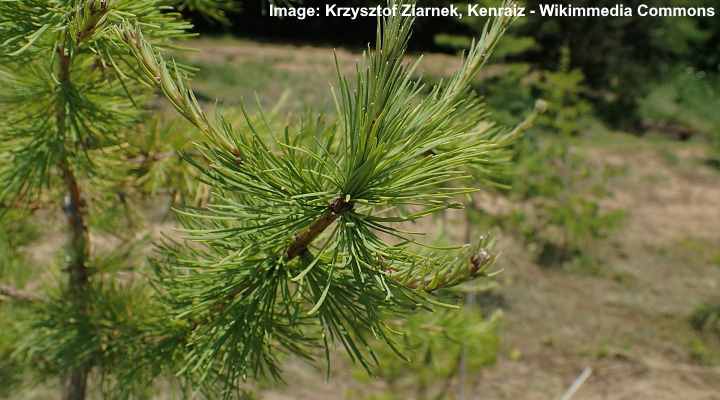
Siberian larches produce needle-like pine leaves in clusters of up to 40 needles on their light-green foliage. The barrels are oblong and barrel-shaped, measuring between 0.8″ and 2″ (2 cm) in length. Pinkish-red immature larch cones or blooms gradually transform into brown hard seed cones.

The female flower of Siberian larch (strobilus)
Other Types of Larch Trees

On the left is Alpine larch (Larix lyallii), while on the right is Dahurian larch (Larix gmelinii). Other kinds of larches include:
Alpine larch (Larix lyallii)—In subalpine woodlands, the cold-hardy North American larch grows up to 80 feet (25 meters) tall. The needle leaves are 2 inches (5 cm) long, flaky grey bark, and barrel-shaped crimson cones with green whiskers.
Dahurian larch (Larix gmelinii)—Between 32 and 98 feet (10 and 30 meters) tall, this medium-sized European conifer. Small ovoid green cones and short needle leaves grow in tufts on the cold-hardy larch.
